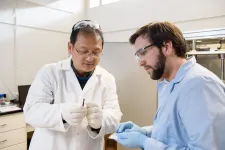(Press-News.org) Scientists have figured out how to modify CRISPR's basic architecture to extend its reach beyond the genome and into what's known as the epigenome -- proteins and small molecules that latch onto DNA and control when and where genes are switched on or off.
In a paper published April 9, 2021, in the journal Cell, researchers at UC San Francisco and the Whitehead Institute describe a novel CRISPR-based tool called "CRISPRoff," which allows scientists to switch off almost any gene in human cells without making a single edit to the genetic code. The researchers also show that once a gene is switched off, it remains inert in the cell's descendants for hundreds of generations, unless it is switched back on with a complementary tool called CRISPRon, also described in the paper.
Because the epigenome plays a central role in many diseases, from viral infection to cancer, CRISPRoff technology may one day lead to powerful epigenetic therapies. And since this approach doesn't involve any DNA edits, it's likely to be safer than conventional CRISPR therapeutics, which have been known to cause unwanted and potentially harmful changes to the genome.
"Though genetic and cellular therapies are the future of medicine, there are potential safety concerns around permanently changing the genome, which is why we're trying to come up with other ways to use CRISPR to treat disease," said Luke Gilbert, PhD, a professor at UCSF's Helen Diller Family Comprehensive Cancer Center and co-senior author of the new paper.
Transforming CRISPR From Genome to Epigenome Editor
Conventional CRISPR is equipped with two pieces of molecular hardware that make it an effective gene-editing tool. One component is a DNA-snipping enzyme, which gives CRISPR the ability to alter DNA sequences. The other is a homing device that can be programmed to zero in on any DNA sequence of interest, imparting precise control over where edits are made.
To build CRISPRoff, the researchers dispensed with conventional CRISPR's DNA-snipping enzyme function while retaining the homing device, creating a stripped-down CRISPR capable of targeting any gene, but not editing it. Then they tethered an enzyme to this barebones CRISPR. But rather than splicing DNA, this enzyme acts on the epigenome.
The new tool targets a particular epigenetic feature known as DNA methylation, which is one of many molecular parts of the epigenome. When DNA is methylated, a small chemical tag known as a methyl group is affixed to DNA, which silences nearby genes. Although DNA methylation occurs naturally in all mammalian cells, CRISPRoff offers scientists unprecedented control over this process. Another tool described in the paper, called CRISPRon, removes methylation marks deposited by CRISPRoff, making the process fully reversible.
"Now we have a simple tool that can silence the vast majority of genes," said Jonathan Weissman, PhD, Whitehead Institute member, co-senior author of the new paper and a former UCSF faculty member. "We can do this for multiple genes at the same time without any DNA damage, and in a way that can be reversed. It's a great tool for controlling gene expression."
"Major Surprise" Upends A Basic Tenet of Epigenetics
Based on previous work by a group in Italy, the researchers were confident that CRISPRoff would be able to silence specific genes, but they suspected that some 30 percent of human genes would be unresponsive to the new tool.
DNA consists of four genetic letters -- A, C, G, T -- but, in general, only Cs next to Gs can be methylated. To complicate matters, scientists have long believed that methylation could only silence genes at sites in the genome where CG sequences are highly concentrated, regions known as "CpG islands."
Since nearly a third of human genes lack CpG islands, the researchers assumed methylation wouldn't switch these genes off. But their CRISPRoff experiments upended this epigenetic dogma.
"What was thought before this work was that the 30 percent of genes that do not have CpG islands were not controlled by DNA methylation," said Gilbert. "But our work clearly shows that you don't require a CpG island to turn genes off by methylation. That, to me, was a major surprise."
Epigenetic Inheritance Enhances CRISPRoff's Therapeutic Potential
Easy-to-use epigenetic editors like CRISPRoff have tremendous therapeutic potential, in large part because, like the genome, the epigenome can be inherited.
When CRISPRoff silences a gene, not only does the gene remain off in the treated cell, it also stays off in the descendants of the cell as it divides, for as many as 450 generations.
To the researchers' surprise, this held true even in maturing stem cells. Though the transition from stem cell to differentiated adult cell involves a significant rewiring of the epigenome, the methylation marks deposited by CRISPRoff were faithfully inherited in a significant fraction of cells that made this transition.
These findings suggest that CRISPRoff would only need to be administered once to have lasting therapeutic effects, making it a promising approach for treating rare genetic disorders -- including Marfan syndrome, which affects connective tissue, Job's syndrome, an immune system disorder, and certain forms of cancer -- that are caused by the activity of a single damaged copy of a gene.
The researchers noted that although CRISPRoff is exceptionally promising, further work is needed to realize its full therapeutic potential. Time will tell if CRISPRoff and similar technologies are indeed "the future of medicine."
INFORMATION:
About UCSF: The University of California, San Francisco (UCSF) is exclusively focused on the health sciences and is dedicated to promoting health worldwide through advanced biomedical research, graduate-level education in the life sciences and health professions, and excellence in patient care. UCSF Health, which serves as UCSF's primary academic medical center, includes top-ranked specialty hospitals and other clinical programs, and has affiliations throughout the Bay Area. UCSF School of Medicine also has a regional campus in Fresno. Learn more at ucsf.edu, or see our Fact Sheet.
Follow UCSF
ucsf.edu | Facebook.com/ucsf | YouTube.com/ucsf
Look deep inside the brain of someone with Alzheimer's disease, most forms of dementia or the concussion-related syndrome known as chronic traumatic encephalopathy (CTE) and you'll find a common suspected culprit: stringy, hairball-like tangles of a protein called tau.
Such conditions, collectively known as "tauopathies" strike scores of people across the globe, with Alzheimer's alone affecting six million people in the United States.
But more than a century after German psychiatrist Alois Alzheimer discovered tau tangles, scientists still have much to ...
What The Study Did: The fitted filtration efficiency of commonly available masks worn singly, doubled or in combinations was evaluated in this study.
Authors: Emily E. Sickbert-Bennett, Ph.D., M.S., of the UNC Medical Center in Chapel Hill, North Carolina, is the corresponding author.
To access the embargoed study: Visit our For The Media website at this link https://media.jamanetwork.com/
(doi:10.1001/jamainternmed.2021.2033)
Editor's Note: The article includes conflict of interest and funding/support disclosures. Please see the article for additional information, including other authors, author contributions and affiliations, conflict of ...
CHAPEL HILL, NC - A study published today in JAMA Internal Medicine shows that wearing two face coverings can nearly double the effectiveness of filtering out SARS-CoV-2-sized particles, preventing them from reaching the wearer's nose and mouth and causing COVID-19. The reason for the enhanced filtration isn't so much adding layers of cloth, but eliminating any gaps or poor-fitting areas of a mask.
"The medical procedure masks are designed to have very good filtration potential based on their material, but the way they fit our faces isn't perfect," said Emily ...
Thermoelectrics directly convert heat into electricity and power a wide array of items -- from NASA's Perseverance rover currently exploring Mars to travel coolers that chill beverages.
A Clemson University physicist has joined forces with collaborators from China and Denmark to create a new and potentially paradigm-shifting high-performance thermoelectric compound.
A material's atomic structure, which is how atoms arrange themselves in space and time, determines its properties. Typically, solids are crystalline or amorphous. In crystals, atoms are in an orderly and symmetrical pattern. Amorphous materials have randomly distributed atoms.
Clemson researcher Jian He and the international team created a new hybrid compound in which the crystalline and ...
Russian scientists have proposed a theory of phase transformation in polymer gels. It explains the mechanisms of the dramatic reduction in volume of zwitterionic hydrogels when they are cooled. The results are published in the journal Chemical Communications (ChemComm).
Polymer gels have unusual properties, including the ability to absorb water in volumes hundreds of times greater than their own. For example, some hydrogels are capable of holding up to two kilograms of water per gram of dry gel. By changing the temperature or adding solvents, various desired properties can be achieved. This is why polymer gels are used in industry and biomedicine, including for the targeted delivery of medication, creation of artificial skin, children's toys, etc.
If you take ...
Two new studies published in Blood suggest that the mRNA COVID-19 vaccine may have reduced efficacy in individuals with chronic lymphocytic leukemia (CLL) and multiple myeloma, two types of blood cancer. According to researchers, these studies could help inform the ideal time for vaccination of these populations.
Study suggests two-dose COVID-19 vaccine is less effective for people with CLL as compared to healthy controls
The first study reports that people with CLL had markedly lower immune response rates to the two-dose mRNA COVID-19 vaccine than healthy individuals ...
Underground pipelines that transport oil and gas are very important engineering communications worldwide. Some of these underground communications are built and operated in earthquake-prone areas.
Seismic safety or seismic stability of underground pipelines began to be intensively studied since the 1950s.
Since then, a number of methodologies were proposed for calculating stress received by an underground pipeline during an earthquake. The purpose of these methodologies was to make an accurate prediction on the structural stress received by a pipeline during an earthquake, and thus it would allow to decide ...
A virtual human can be as good as a flesh-and-blood one when it comes to helping people practice new leadership skills. That's the conclusion from new research published in the journal Frontiers in Virtual Reality that evaluated the effectiveness of computer-generated characters in a training scenario compared to real human role-players in a conventional setting.
Practice-based training techniques, including role-playing, are sometimes used to help improve training outcomes. However, these methods can be expensive to implement, and often require specialized knowledge and even professional actors to create realistic training environments. In addition, some ...
The preliminary trial results of a novel radiopharmaceutical for PET imaging of inflammation developed at the University of Turku, Finland, have been published. The compound, which targets the vascular adhesion protein 1 (VAP-1) that regulates inflammatory cell traffic, is the first radiopharmaceutical that has been developed completely in Finland and has advanced to clinical trials. In the study that started with healthy volunteers, the radiopharmaceutical was found to be well tolerated and safe.
The radiopharmaceutical is 68Ga-labelled Siglec-9 peptide.
"The dose of the radiopharmaceutical ...
"It is machination, it is deception," said the Director General of the Berlin Royal Museums in his defence when criticized for buying a fake. Wilhelm Bode did not budge an inch: the sculpture he acquired in 1909 was an as yet unknown production of the great Renaissance master, Leonardo da Vinci. After one hundred years and numerous controversies, a group of scientists led by a CNRS researcher* has just proven him wrong once and for all. The Flora wax bust, conserved at the Bode Museum in Berlin, recently underwent radiocarbon (14C) dating, which provided both a precise date and an incontrovertible result: it was made in the nineteenth century, nearly 300 years after da Vinci's death. As the sculpture was made primarily from spermaceti, ...





